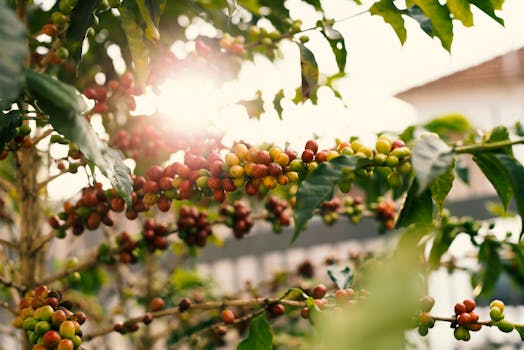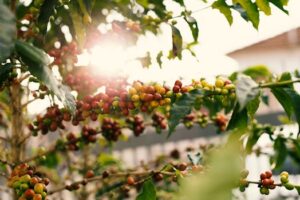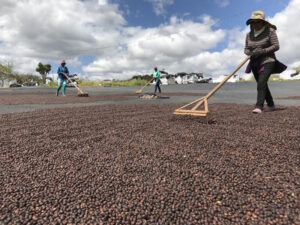For folks just starting to get into specialty coffee, the options are endless. Not just for where you buy your coffee, but what kind of coffee you can buy. Nowadays, specialty roasters use all kinds of terminology to describe their product, including its origin, roast level, and process. That last one, coffee processing, is only one step of a long journey coffee makes from crop to cup. But it’s an important step for determining the flavor profile of coffee beans. It also might be the most overlooked.
Perhaps in your perusing coffee for home you’ve noticed the words “washed,” “natural,” or “honey-processed” used to describe a batch of coffee. You may, for example, see them when checking out the breakdowns of beans you can buy here at Raj’s Coffee. These aren’t just pretentious descriptions! Neither do they describe whether a coffee batch is “clean” or not. In fact, these terms denote the method by which a coffee crop was processed. To understand what these terms mean, we’ll need to dig a little bit into the coffee journey.
Coffee Cherries
Coffee beans begin their lives as seeds, or “cherries,” of the coffea tree. These cherries, much like other members of the stone fruit family (like apricots and plums) have several layers to them. Actually, coffee cherries have up to 7 layers from outer skin to inner seed. But unlike those other stone fruits, coffee cherries are harvested specifically for their seeds instead of their flesh. This means that the flesh of the cherry needs to be removed before the beans inside can be prepared and shipped.
This is where processing comes in. Producers need to separate the flesh of the cherry from the seed once the cherry is harvested. The method by which the producer goes about doing this is what is generally called processing. And it’s also what determines the label of “washed,” “natural,” or “honey.”
The Washed Process
A “washed” coffee simply means that the flesh of the cherries are stripped off via water. To accomplish this, producers feed the cherries through a de-pulping machine. After this they are moved into troughs of water where they are left to ferment. Once the fermentation process is complete, the remaining parts of the outer layer are washed away. Finally, the seeds – the coffee beans – are placed outside to dry in the sun. At this point, the producers may periodically rake the beans so that they dry evenly.
“Washed” coffee beans tend to result in coffee with subtle but pleasant flavor. Not only is this flavor palette considered widely desirable for the mass market, the washing process is engineered for consistency. It’s true that washed coffees may not have the brightest or loudest flavors. But what washed coffee lacks in dynamic flavor it makes up for with balance and consistency. I personally think that washed coffees work really well when brewed with automatic drip machines. They also work well for iced coffee and cold brew. Really any brewing method where uniform, solid flavor is the goal.
Most coffee sold in the worldwide market is washed. This means that when you come across a batch of coffee with no clear processing label, chances are high that it was washed. But if you do see a coffee bag labelled washed, then the roaster likely considers the flavor afforded by the washing process desirable. I personally have enjoyed many washed coffees, both in blends and single-origin batches. And if you’re an avid coffee drinker, then you have likely tasted a washed coffee that you enjoy. It’s become industry-standard for a reason!
The Natural Process
But the industry didn’t always have the machinery used for washing. For a long time, coffee producers only processed their coffee the “natural” way. This means that once the cherries are picked, they are left out to dry in the sun with the flesh still intact. This amounts to a different form of fermentation, one in which the flavors of the mucilage, the outermost layer of the cherry, find their way into the seeds. Beans processed this way tend to yield fruitier, earthier notes with less acidity than their washed counterparts.
Natural processing comes with a clear benefit along with a drawback. It’s expensive to use the amount of water necessary for a successful washing process. By skipping the use of water altogether, producers can save on a major cost. In fact, for many parts of the coffee-growing world where water is less available, the natural process may be the only option. At the same time, natural processing exposes the cherries to risk of rot and mold. Producers have to carefully monitor the cherries to ensure they stay free of these defects.
But the results are vibrant flavors that are typically lost in the washing process. When a natural processed coffee hits the roaster’s shelves, you can bet that the beans were thoroughly checked for defects on both the producer’s and roaster’s end. Nevertheless, natural processed coffee can be a bit polarizing, as not everyone considers its earthy and wild notes to be desirable. I recommend you taste at least one natural coffee when you have the chance, just to see what you think of it. Next time you’re in a café and you see a natural option on pour-over, give it a try!
The Honey Process
Finally, there’s the “honey” process. This basically splits the difference between “washed” and “natural.” When cherries are “honey” processed, the outer skin of the cherries are still removed with a pulping machine. However, they are not sent to water tanks to be fermented. Instead, they are immediately sent to drying racks or patios with parts of their fruit still intact.
Because of this splitting the difference, “honey” processed coffees tend to feature some of the subtle, acidic flavors of washed coffee and some of the fruitier, earthier notes of natural coffee. If you’re wondering why this process is called “honey,” it’s because in Central America especially, producers refer to the mucilage of the cherries as miel, or honey.
Conclusion
There are many other terms in the coffee world when it comes to processing and fermentation. Honey processing alone actually has a whole spectrum of terms for those interested. But these three – washed, natural, and honey – are the ones you are most likely to see in a café or a roaster’s online store. (Including ours!) Hopefully these give you the direction you need to try new coffees and seek your favorite flavors.





